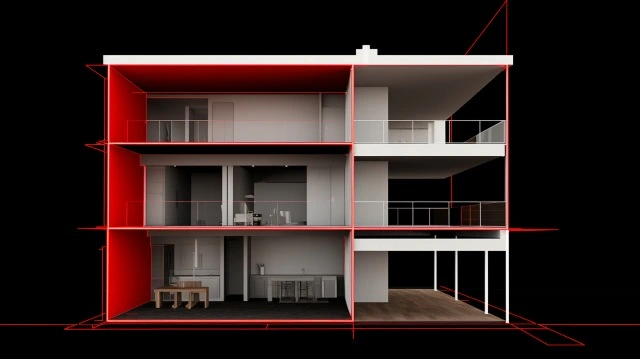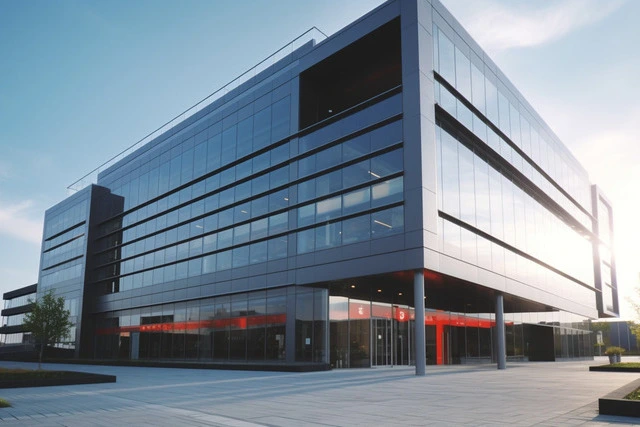A building envelope is one of the most critical components in a building’s functionality and energy efficiency. This barrier between interior and exterior environments regulates temperature, moisture, airflow, and noise control. With rising energy costs and a growing focus on sustainability, properly designing and optimizing the envelope is essential for any new construction or retrofit project.
What is a building envelope?
The building envelope refers to the physical separator between the interior and exterior environments of a building. It comprises exterior walls, roof, foundation, doors, and doors. It is a critical factor in determining real estate energy efficiency.

Physical components
The main components that make up the building envelope include:
- Exterior walls: The exterior walls contribute thermal insulation, weather resistance, and sound insulation to the building envelope. Standard wall assemblies include brick veneer, stucco, siding, stone veneer, and precast concrete panels.
- Roof: Protecting the interior from weather elements and providing thermal insulation, ceilings majorly impact the building envelope. Pitched roofs with shingles are most common for smaller buildings, while flat roofs with built-up membranes are typical for large commercial buildings.
- Foundation: The foundation transfers structural loads to the earth while protecting the building from ground moisture. Concrete slabs, crawlspaces, and basements are typical foundation types.
- Windows: Windows allow natural light into a building while regulating heat flow. High-performance glazing improves insulation, while operable windows facilitate natural ventilation.
- Doors: Exterior doors control access and maintain climate separation similar to windows. Well-sealed doors with proper weatherstripping reduce air leakage.
What does ‘within the building envelope’ mean?
“Within the building envelope” refers to being inside the protective shell formed by the roof, walls, and foundation. Anything within the building envelope is separated from the outside environment. Building systems like HVAC, plumbing, and electrical wiring are within the envelope. Building envelope also defines the border for a building’s conditioned space.
Factors to consider
Some key factors to consider for an effective building envelope include:
- Thermal performance: Proper thermal design resists heat flow and reduces HVAC loads. Insulation levels, types, installation methods, thermal bridging, window glazing, and window framing can all impact the thermal performance of a building envelope.
- Air sealing: To assess the air sealing of a building envelope, look at the sealing of cracks and joints and the connections on walls, openings, and penetrations that use caulks, foams, and tapes. High-quality weatherstripping on doors and windows can also help improve the air sealing of a building envelope.
- Moisture control: Water-resistive barriers beneath exterior cladding and flashing at intersections, penetrations, and transitions can control rainwater intrusion. Drainage away from the foundation and water vents in wall and roof assemblies can help prevent moisture.
- Durability: Protecting the interior of a building from environmental conditions requires a durable building envelope. Impact and weather-resistant exterior materials and finishes can help enhance the durability of a building envelope. To assess the durability of materials and finishes, consider UV exposure ratings, water repellency, corrosion resistance, and maintainability.
Are there any similar terms for it?
The building envelope is also referred to by several other related terms that deal with the exterior structure of a building. While building envelope is the most widely used all-encompassing term, other phrases are often used interchangeably or to focus on specific components of the envelope system. The terminology differs based on factors like scope and context.
Building enclosure
A building enclosure is the same boundary separating indoor and outdoor environments as a building envelope. Both terms refer to the same basic concept. “Enclosure” emphasizes the idea of a closed continuous system around a building.
Façade
Façade refers specifically to the exterior face of a building, especially the front or main face featuring architectural detailing. It comprises the exterior walls and fenestration but does not typically include the roof or foundation. Façade is a narrower term focusing only on the outward appearance rather than the whole envelope system.
Benefits of an optimized building envelope
An optimized building envelope with proper insulation, air sealing, moisture protection, and durability provides many benefits, including:
- Improved energy efficiency: Less heat transfer means lower HVAC costs for heating and cooling.
- Greater temperature and climate control: The envelope prevents indoor conditions from being affected by outdoor temperatures.
- Reduce moisture issues: Effective moisture control prevents mold, rot, and indoor air quality problems.
- Enhanced durability: Quality materials that create an effective building envelope withstand weathering and last longer before needing repairs.
- Improved air quality and ventilation: Tight construction reduces drafts and ingress of pollutants.
- Better noise control: Envelope air tightness and insulation provide sound dampening.
- Increased property value: An optimized envelope remains attractive and functional for longer.
Function in commercial real estate
In commercial real estate, the building envelope plays a critical role in the functionality and performance of properties.
Enhancing property performance through building envelope systems
Optimizing a building envelope can improve the value and competitiveness of commercial buildings in many ways, including:
- Lower operating expenses: Improving insulation, HVAC efficiency, and moisture control reduces utility and maintenance costs.
- Healthier interior environment: An airtight envelope prevents moisture issues and allows better indoor air quality control.
- Increased rentability: Envelope upgrades like better insulation improve tenant comfort and make leasing units easier.
- Higher rents and sales prices: Optimized envelopes allow owners to command higher rents and make properties more attractive to potential buyers.
- Extended building lifespan: A durable envelope with ongoing upgrades extends the functional lifespan of the asset.
- Improved aesthetics: A well-maintained façade enhances curb appeal and projects a modern, high-quality image.
- Regulatory compliance: Envelope enhancements often align with stricter energy codes and environmental regulations.
- Certification opportunities: A tight, well-insulated envelope better positions buildings for LEED and ESG Green Buildings certification.
- Alignment with tenant values: Tenants increasingly favor efficient, healthy, and sustainable buildings in lease decision-making.
Smart building envelope solutions for CRE businesses
Emerging ‘smart’ envelope solutions provide additional opportunities to future-proof your assets, including:
- Advanced materials: Smart glazing materials such as aerogels and photovoltaic glass can reduce solar heat gain from entering the building.
- Energy generation: Solar cells integrated directly into the facade or roof can generate electricity.
- Automated sensors: Sensors in envelope components can monitor performance metrics like air leaks, temperature, and humidity. Software solutions such as ProptechOS partners Greenview can handle and analyze this data to notify building operators of abnormalities.
- Predictive analytics: Advanced modeling and simulation can forecast energy efficiency and inform targeted envelope upgrades with the most significant impact. You can integrate this data with building management systems to better inform predictive maintenance.
- Adaptive facades: Automated windows, louvers, and shutters can modulate daylight, ventilation, and insulation to optimize energy efficiency.
- Responsive shading: Motorized exterior shading systems can optimize solar gain and glare control.
By implementing intelligent building envelope strategies, you can maximize your portfolio’s resilience, efficiency, and appeal to tenants.
Why does it matter?
Leveraging building envelope innovations allows commercial real estate firms to maximize asset returns while future-proofing their portfolios. With heating and cooling costing about one-third of a building’s energy expenses, smart solutions for building envelopes provide a strong RoI. Building envelope improvements can also help mitigate risks, improve the tenant experience, and future-proof against environmental requirements.
To optimize the value of your smart building solutions, ProptechOS creates a unified ecosystem for all of your Proptech. This unified ecosystem enables smart solutions to work collaboratively toward enhancing the efficiency of your building. You can try ProptechOS for free today to see how a unified ecosystem for all of your smart building systems can improve the value of each solution.
